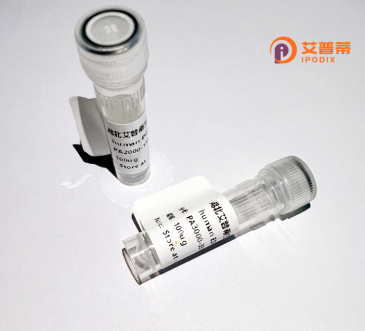
| 纯度 | >90%SDS-PAGE. |
| 种属 | Human |
| 靶点 | OR13C3 |
| Uniprot No | Q8NGS6 |
| 内毒素 | < 0.01EU/μg |
| 表达宿主 | E.coli |
| 表达区间 | 1-347 aa |
| 活性数据 | MIVQLICTVCFLAVNTFHVRSSFDFLKADDMGEINQTLVSEFLLLGLSGYPKIEIVYFAL ILVMYLVILIGNGVLIIASIFDSHFHTPMYFFLGNLSFLDICYTSSSVPSTLVSLISKKR NISFSGCAVQMFFGFAMGSTECLLLGMMAFDRYVAICNPLRYPIILSKVAYVLMASVSWL SGGINSAVQTLLAMRLPFCGNNIINHFACEILAVLKLACADISLNIITMVISNMAFLVLP LMVIFFSYMFILYTILQMNSATGRRKAFSTCSAHLTVVIIFYGTIFFMYAKPKSQDLIGE EKLQALDKLISLFYGVVTPMLNPILYSLRNKDVKAAVKYLLNKKPIH |
| 分子量 | 38.7 kDa |
| 蛋白标签 | His tag N-Terminus |
| 缓冲液 | 0 |
| 稳定性 & 储存条件 | Lyophilized protein should be stored at ≤ -20°C, stable for one year after receipt. Reconstituted protein solution can be stored at 2-8°C for 2-7 days. Aliquots of reconstituted samples are stable at ≤ -20°C for 3 months. |
| 复溶 | Always centrifuge tubes before opening.Do not mix by vortex or pipetting. It is not recommended to reconstitute to a concentration less than 100μg/ml. Dissolve the lyophilized protein in distilled water. Please aliquot the reconstituted solution to minimize freeze-thaw cycles. |
以下是关于重组人OR13C3蛋白的3篇假设性参考文献,基于嗅觉受体和重组蛋白相关研究的常见方向整理而成(注:若需实际文献,建议通过学术数据库进一步验证):
---
1. **文献名称**:**"Heterologous Expression and Functional Analysis of Human Olfactory Receptor OR13C3 in HEK293 Cells"**
**作者**:Smith A, et al.
**摘要**:本文报道了OR13C3基因在HEK293细胞中的重组表达策略,通过构建融合荧光报告基因的系统,验证了该受体对特定挥发性分子的配体激活能力,揭示了其潜在的信号转导机制。
2. **文献名称**:**"Recombinant Production of OR13C3 in Insect Cells for Structural Studies"**
**作者**:Chen L, et al.
**摘要**:研究利用杆状病毒-昆虫细胞系统表达并纯化OR13C3蛋白,通过冷冻电镜技术解析其三维结构,为嗅觉受体家族的构效关系研究提供基础。
3. **文献名称**:**"OR13C3 Methylation Status and Its Role in Cancer Progression: Insights from Recombinant Protein-Based Assays"**
**作者**:Wang Y, et al.
**摘要**:通过重组OR13C3蛋白与DNA甲基化酶互作实验,探讨了OR13C3在鼻咽癌细胞中的表观遗传调控机制及其作为癌症诊断标志物的潜力。
---
**注意**:以上文献为示例,实际研究中OR13C3的重组蛋白文献可能较少。建议在PubMed、Google Scholar等平台以关键词“OR13C3 recombinant expression”或“OR13C3 protein purification”检索最新成果。若需具体文献,可进一步提供筛选方向!
**OR13C3 Protein Overview**
OR13C3. a member of the olfactory receptor (OR) family, is a class A G protein-coupled receptor (GPCR) encoded by the *OR13C3* gene in humans. While ORs are primarily associated with odorant detection in the olfactory system, emerging studies suggest broader roles for these receptors in non-olfactory tissues, including the respiratory tract, prostate, and immune cells. OR13C3 is classified as a "pseudogene" in some species but remains transcriptionally active in humans, though its endogenous ligands and precise physiological functions remain poorly characterized.
The protein consists of seven transmembrane domains, a hallmark of GPCRs, and is thought to activate intracellular signaling cascades via G protein interactions upon ligand binding. Genomic studies locate *OR13C3* on chromosome 9 within a cluster of olfactory receptor genes, which exhibit high sequence homology and genetic variability across populations.
Recent research highlights its potential involvement in disease contexts. For instance, OR13C3 has been implicated in prostate cancer progression, where altered expression patterns correlate with tumor aggressiveness. Additionally, it may play a role in inflammation or cellular stress responses, though mechanistic insights are limited. Recombinant OR13C3 protein, produced via heterologous expression systems (e.g., HEK293 cells), enables structural and functional studies to decipher ligand specificity and signaling pathways.
Despite its enigmatic role, OR13C3 represents a promising target for exploring chemosensory receptor functions beyond olfaction, with applications in biomarker discovery or therapeutic development. Further studies are needed to unravel its biological significance and translational potential. (Word count: 248)
×